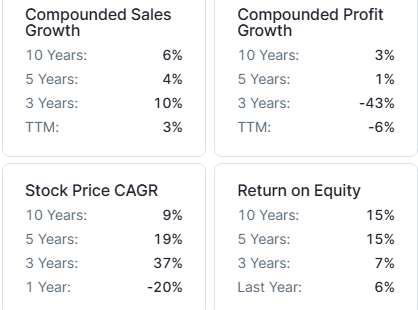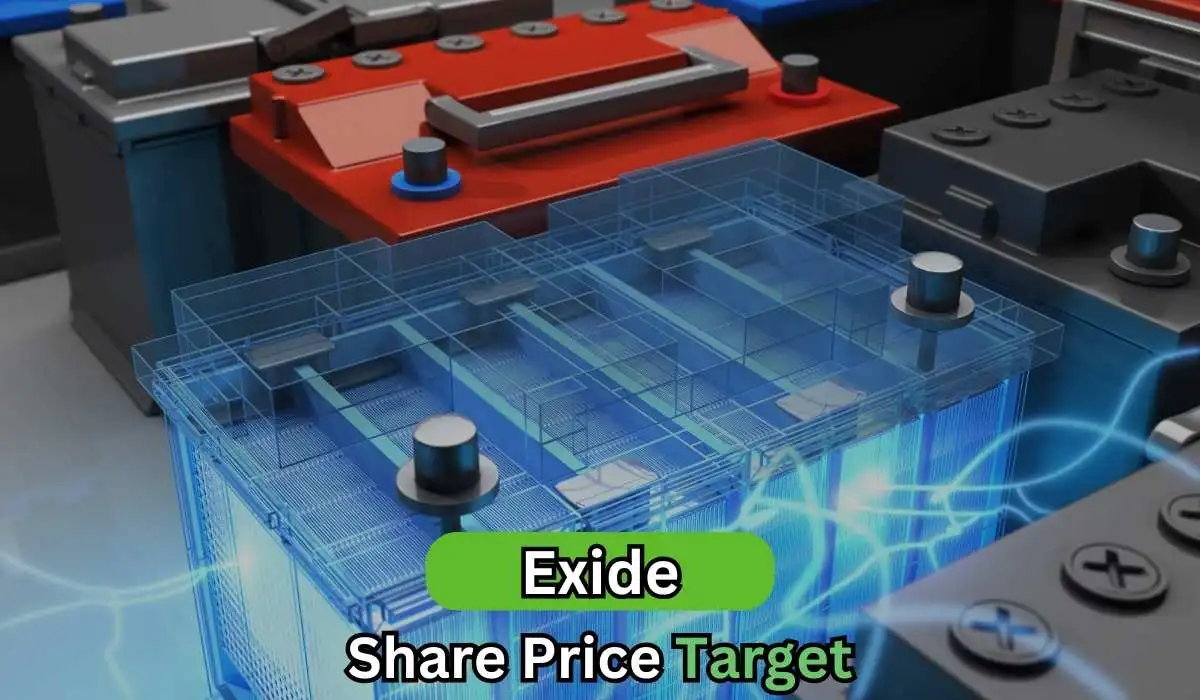Exide Industries was listed on the NSE on June 17, 2003. In the last five years, the company has given a massive return of more than 130% to its investors. Will Exide continue to provide such great returns in the future as well? Let’s explore Exide Industries’ growth potential and Exide Industries share price target from 2025 to 2050 in this article.
About Exide Industries
Exide Industries manufactures batteries for automobiles, bicycles, inverters, and industrial applications. It was founded in 1947 and is one of India’s leading battery manufacturers. The company manufactures various types of batteries, including lead-acid and lithium-ion, for a variety of applications. Exide is a major player in both the automotive and industrial sectors, supplying batteries to car manufacturers, telecommunications companies, and power backup systems. It also has manufacturing facilities throughout India and exports its products to various countries.
Exide Industries Business Model
- Battery Sales: Exide sells a variety of batteries for automobiles, bikes, trucks, and industrial machines. This is its main source of revenue.
- Industrial Batteries: The company manufactures large batteries used in telecom towers, solar panels, and large factories. These batteries help with power backup.
- Home Inverters: Exide sells inverters and batteries for homes to supply electricity during power outages.
- Recycling: Exide collects old batteries, recycles them, and reuses the materials to create new batteries. This lowers costs and increases profits.
- Exports: The company exports its batteries to a number of countries, which helps it generate additional revenue.
- OEM Supply: Exide sells batteries directly to car and bike companies, which use them in new vehicles before selling to customers.
- Aftermarket Sales: When people need new batteries for their vehicles or machines, they buy Exide batteries from shops. This is a major income source.
- Service & Maintenance: Exide provides battery maintenance, testing, and repair services, which help in earning extra money.
Exide Industries Fundamental Analysis
| Stock Name | Exide Industries Ltd. |
|---|---|
| NSE Symbol | EXIDEIND |
| Market Cap | ₹ 30,681 Cr. |
| 52W High | ₹ 620 |
| 52W Low | ₹ 328 |
| Stock P/E | 38.6 |
| Book Value | ₹ 164 |
| Dividend Yield | 0.55 % |
| ROCE | 8.87 % |
| ROE | 5.93 % |
| Face Value | ₹ 1.00 |
| Industry PE | 23.6 |
| Price to book value | 2.21 |
| Debt to equity | 0.14 |
| PEG Ratio | 67.7 |
| Quick ratio | 0.45 |

| Shareholders | March 2023 | March 2024 | March 2025 |
|---|---|---|---|
| Promoters | 45.99% | 45.99% | 45.99% |
| FIIs | 12.32% | 13.57% | 11.60% |
| DIIs | 18.92% | 18.57% | 17.15% |
| Government | 0.00% | 0.00% | 0.00% |
| Public | 22.76% | 21.88% | 25.25% |
| No. of Shareholders | 7,17,785 | 9,43,331 | 13,38,262 |
Key Factors Driving Exide Industries Future Growth
- Strong Brand Reputation: Exide’s strong brand reputation helps it attract more customers.
- Expanding Product Line: Exide is constantly adding new and improved battery solutions for a variety of industries, including automobiles, industrial equipment, and renewable energy.
- Growing Demand for Electric Vehicles (EVs): As more people adopt electric vehicles, Exide’s battery business is expected to expand significantly.
- Investment in Advanced Technology: Exide invests in advanced technology to develop high-performance, long-lasting batteries.
- Focus on Renewable Energy: As solar and wind energy become more prevalent, Exide is developing batteries that can efficiently store power, expanding its market opportunities.
- Strong Distribution Network: Exide has a wide network of dealers and service centers, making its products easily available to customers.
- Expansion in International Markets: Exide’s expansion into international markets is resulting in higher sales and profits.
- Strategic Partnerships and Collaborations: Exide is working with other companies to improve its technology and expand its business.
- Government Support and Policies: Exide benefits from government policies promoting clean energy and electric vehicles, which increases battery demand.
- Focus on Sustainability: Exide is developing eco-friendly battery solutions and recycling programs to attract environmentally conscious customers.
Pros of Exide Industries
- Low Debt Levels: With a low debt-to-equity ratio of 0.14, Exide has a minimum dependency on debt, reducing financial risk and interest expenses.
- Increase in Institutional Confidence: DIIs have increased their holding to 17.64% in December 2024 from 17.96% in September 2024 while FIIs have increased their holding to 11.72% in December 2024 from 12.31% in September 2024, indicating a strong institutional confidence in the company’s future growth prospects.
- Low Debt Levels: Exide Industries debt to equity ratio is 0.14, which indicates that the company is less dependent on debt, which reduces its financial risk.
Cons of Exide Industries
- Poor Sales Growth – Exide has delivered a poor sales growth of 3% over the last five years.
- Poor Profit Growth – Exide profit has grown at a CAGR of just 2% over the last five years, showing weak earnings growth over time.
- Overvaluation Concern: Exide is trading at a PE ratio of 37.4, which is relatively higher than the industry average of 24.6, which indicates that the stock may be overvalued compared to its peers.
- Poor Sales Growth – Exide Industries has delivered a poor sales growth of 4% over the last five years.
- Poor Profit Growth – Exide Industries profit has grown at a CAGR of just 3% over the last ten years, showing weak earnings growth over time.
- Overvaluation Concern: Exide Industries stock is trading at a PE ratio of 38.6, which is relatively higher than the industry average of 23.6 , which indicates that the stock is overvalued compared to its peers.
- Decrease in Institutional Confidence: DIIs have reduced their holding to 17.15% in March 2025 from 17.64% in December 2024 while FIIs have reduced their holding to 11.60% in March 2025 from 11.72% in December 2024, indicating a decline in institutional confidence in the company’s future growth prospects.
Exide Industries Ltd Balance Sheet
| Particulars | March 2023 | March 2024 | March 2025 |
|---|---|---|---|
| Equity Capital | 85 | 85 | 85 |
| Reserves | 11,047 | 12,801 | 13,828 |
| Borrowings | 588 | 1,123 | 2,017 |
| Other Liabilities | 3,037 | 4,140 | 5,466 |
| Total Liabilities | 14,758 | 18,149 | 21,396 |
| Fixed Assets | 3,682 | 3,853 | 4,153 |
| CWIP | 525 | 1,352 | 3,426 |
| Investments | 5,106 | 5,940 | 6,468 |
| Other Assets | 5,444 | 7,004 | 7,350 |
| Total Assets | 14,758 | 18,149 | 21,396 |
By the end of 2025, the Exide Industries share price is expected to be around ₹500 in normal conditions. In a bear market, it might be ₹450, and in a bull market, it may go up to ₹560.
| Exide Industries Share Price Target 2025 | Rupees (₹) |
|---|---|
| 1st Target | 450 |
| 2nd Target | 500 |
| 3rd Target | 560 |
In 2026, the Exide Industries share price is expected to be around ₹600 in a normal situation. In a bear market, it might be ₹540, and in a bull market, it may cross ₹730.
| Exide Industries Share Price Target 2026 | Rupees (₹) |
|---|---|
| 1st Target | 540 |
| 2nd Target | 600 |
| 3rd Target | 730 |
According to our analysis, the Exide Industries share price is expected to be around ₹750 in 2027. In a bear market, it might be ₹650, and in a bull market, it may cross ₹950.
| Exide Industries Share Price Target 2027 | Rupees (₹) |
|---|---|
| 1st Target | 650 |
| 2nd Target | 750 |
| 3rd Target | 950 |
According to our analysis, the Exide Industries share price may trade near ₹1000 by 2028; bearish conditions could pull it down to ₹800, while a strong bull run might lift it to ₹1250.
| Exide Industries Share Price Target 2028 | Rupees (₹) |
|---|---|
| 1st Target | 800 |
| 2nd Target | 1000 |
| 3rd Target | 1250 |
In a normal situation, the Exide Industries share price is projected to be approximately ₹1150 in 2029. In a bear market, the value may be as low as ₹950, while in a bull market, it may rise to ₹1600.
| Exide Industries Share Price Target 2029 | Rupees (₹) |
|---|---|
| 1st Target | 950 |
| 2nd Target | 1150 |
| 3rd Target | 1600 |
In a normal situation, the Exide Industries share price is projected to be approximately ₹1500 in 2030. In a bear market, the value may be as low as ₹1150, while in a bull market, it may rise to ₹2100.
| Exide Industries Share Price Target 2030 | Rupees (₹) |
|---|---|
| 1st Target | 1150 |
| 2nd Target | 1500 |
| 3rd Target | 2100 |
By 2035, the Exide Industries share price is projected to be around ₹3500 under normal conditions. In adverse markets, the price could fall to ₹2300, while favorable conditions might push it up to ₹6300.
| Exide Industries Share Price Target 2035 | Rupees (₹) |
|---|---|
| 1st Target | 2300 |
| 2nd Target | 3500 |
| 3rd Target | 6300 |
Under normal conditions, the Exide Industries share price might hit ₹10,000 by 2040. A bearish trend could lower it to ₹4600, whereas a bullish surge could raise it to ₹18,900.
| Exide Industries Share Price Target 2040 | Rupees (₹) |
|---|---|
| 1st Target | 4600 |
| 2nd Target | 10,000 |
| 3rd Target | 18,900 |
In 2050, the Exide Industries share price is expected to be around ₹50,000 in a normal situation. In a bear market, it might be ₹18,400, and in a bull market, it may go up to ₹1,13,400.
| Exide Industries Share Price Target 2050 | Rupees (₹) |
|---|---|
| 1st Target | 18,400 |
| 2nd Target | 50,000 |
| 3rd Target | 1,13,400 |
| Years | Target Price |
|---|---|
| Exide Share Price Target 2025 | ₹450 to ₹560 |
| Exide Share Price Target 2026 | ₹540 to ₹730 |
| Exide Share Price Target 2027 | ₹650 to ₹950 |
| Exide Share Price Target 2028 | ₹800 to ₹1250 |
| Exide Share Price Target 2029 | ₹950 to ₹1600 |
| Exide Share Price Target 2030 | ₹1150 to ₹2100 |
| Exide Share Price Target 2035 | ₹2300 to ₹6300 |
| Exide Share Price Target 2040 | ₹4600 to ₹18,900 |
| Exide Share Price Target 2050 | ₹18,400 to ₹1,13,400 |
Conclusion
In conclusion, Exide Industries has a strong market presence with a diverse business model and growth potential driven by factors such as increasing demand for EV batteries, technological advancements, and expansion into international markets. However, challenges like slow sales and profit growth, as well as high stock valuation, could impact future returns. For the latest updates, you can visit Exide Industries official website.
Disclaimer
This article is for educational purposes only. It is not a stock recommendation and should not be treated as such. Please ask your financial advisor before making any investment decision.

